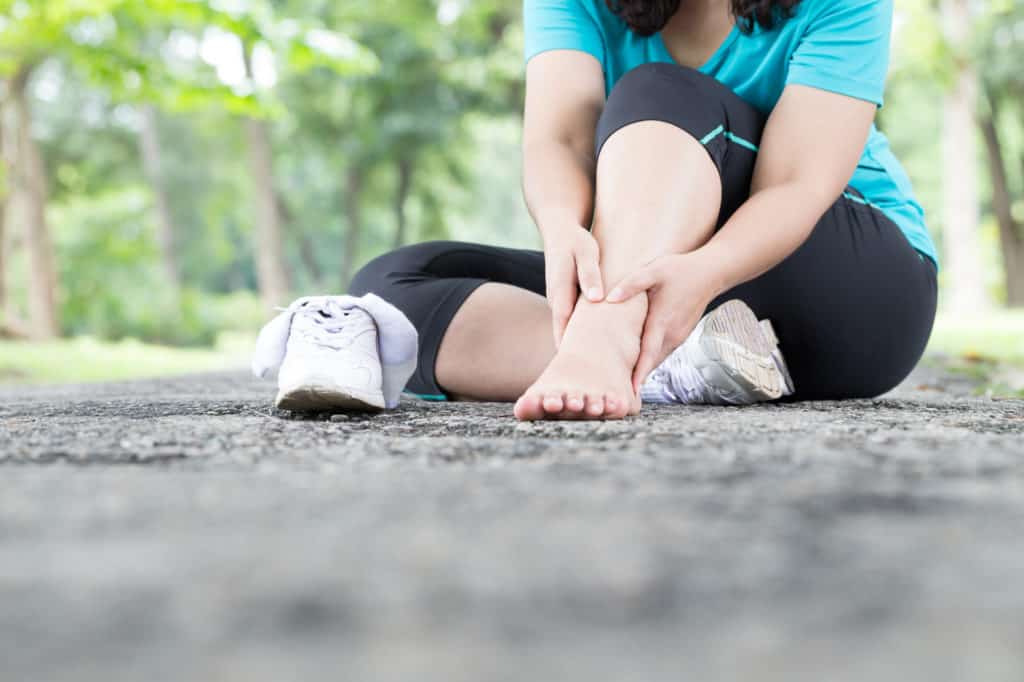Have you ever wondered why mosquitoes seem to have a particularly strong affinity for our feet and ankles? If you’ve spent any time outdoors during mosquito season, you’ve likely felt the wrath of these tiny blood-suckers as they zero in on your lower extremities. It’s not just a figment of your imagination; there’s actually some scientific reasoning behind this annoying phenomenon.
Here Are 3 Reasons Why Mosquitos Target Feet & Ankles
Feet and Ankles are a target for mosquitos this is due to:
Bad Odour around your feet
Your feet are more exposed at night
Relative lack of disturbance
In this blog, we’ll delve into the fascinating world of mosquito behaviour to uncover why they’re so attracted to feet and ankles. We’ll explore the factors that draw these pesky insects to our lower regions, and most importantly, we’ll provide you with practical tips and solutions to protect yourself from their relentless bites. Say goodbye to itchy, swollen ankles and embrace a mosquito-free summer!

Reasons Why Mosquitos Target Ankles And Feet
Attracted To Bad Odour
Mosquitoes are notorious for their keen sense of smell, which they use to track down their next meal. One of the reasons they seem to target our ankles and feet is that these areas can produce a distinct odour that is quite attractive to mosquitoes. Our feet, being enclosed in shoes for extended periods, can become a breeding ground for bacteria that break down sweat and produce volatile compounds with a pungent odour.
The bad odor from our feet is primarily due to the presence of compounds like isovaleric acid, which is produced when bacteria break down sweat. Research has shown that mosquitoes, especially the ones responsible for transmitting diseases like malaria (Anopheles species), are highly attracted to these compounds. This attraction to the smell of our feet gives mosquitoes a strong incentive to focus their bites on our ankles and feet.
To mitigate this problem, it’s important to maintain good foot hygiene. Washing your feet regularly with soap and water, changing socks frequently, and using moisture-absorbing foot powders can help reduce odor and, consequently, make your feet less appealing to mosquitoes. Additionally, you can consider using insect repellents containing DEET or other active ingredients to create a protective barrier around your ankles and feet, making them less attractive to these pesky insects.
-
Kreme Plus 150gm$37.00
Your Feet Not Being Covered Under The Blankets At Night
Another reason mosquitoes tend to target ankles and feet is their accessibility, particularly at night. When we sleep, we often toss and turn, causing our blankets to shift and expose different body parts. Our feet, being at the edge of the bed, are more likely to become uncovered and exposed to the cool night air. This makes them easy targets for mosquitoes searching for a blood meal.
Mosquitoes are attracted to the warmth and carbon dioxide emitted by our bodies. When our feet are exposed, they release both warmth and carbon dioxide into the air, creating an inviting signal for the mosquitoes. Additionally, since our feet are further away from our faces, we may not notice the mosquitoes’ presence as quickly as we would if they were hovering around our heads. This gives the mosquitoes more time to feed undisturbed.
To prevent mosquitoes from feasting on your feet at night, ensure that your feet are properly covered by your blankets or sheets. You can also consider wearing lightweight socks to bed, which can provide an additional layer of protection. To further discourage mosquitoes, use bed nets treated with insecticides or set up a mosquito-repelling device near your bed. These measures will help to reduce the likelihood of mosquitoes targeting your feet and ankles while you sleep.

Relative Lack Of Disturbance
The relative lack of disturbance when mosquitoes bite our lower extremities, such as ankles and feet, plays a role in their preference for these areas. When mosquitoes bite, they pierce the skin with their proboscis to access blood vessels for their meal. Our sensitivity to these bites and our subsequent reactions can disturb the mosquito, making it difficult for them to complete their feeding process.
Our lower extremities, especially the ankles and feet, have several factors that contribute to the relative lack of disturbance when mosquitoes bite:
Reduced sensitivity: Our feet and ankles tend to have thicker skin and less nerve density compared to other body parts like the face, neck, or arms. This means that we might not feel the mosquito bites as quickly or intensely as we would on other areas, giving the mosquito more time to feed undisturbed.
Distance from our hands: Our hands are our primary tools for swatting away or killing mosquitoes. Since our feet and ankles are further away from our hands, it takes more time and effort to reach and react to a mosquito biting in that area. This additional time allows the mosquito to feed longer before being disturbed.
Less visibility: Due to their position on our body, our feet and ankles are often less visible and harder to monitor, particularly when we are standing or walking. This makes it easier for mosquitoes to approach and bite these areas without us noticing.
Distraction: When we are engaged in activities, such as walking, hiking, or socializing, our attention is focused elsewhere, making it less likely that we’ll notice a mosquito biting our feet or ankles. This lack of awareness provides an opportunity for the mosquito to feed with minimal disturbance.
By understanding these factors, we can take proactive measures like wearing protective clothing, using insect repellents, and implementing other preventative strategies to minimize the chances of being bitten by mosquitoes.
Ways To Stop Mosquitos From Biting You
Mosquito Nets
Using a mosquito net can be an effective way to avoid mosquito bites on your ankles and feet, particularly when you are sleeping or resting in areas where mosquito populations are high. Here’s how to use a mosquito net effectively to protect your lower extremities:
Choose the right mosquito net: Select a mosquito net that is specifically designed for beds or sleeping areas. Ensure that the net has a fine mesh size (at least 200 holes per square inch) to prevent mosquitoes from passing through. Opt for a net treated with insecticide, such as permethrin, for added protection.
Set up the net properly: Hang the mosquito net from a support structure above your bed or sleeping area, ensuring that it covers the entire area and drapes down to the floor. This will create a protective barrier around your sleeping space, preventing mosquitoes from reaching your feet and ankles.
Tuck in the edges: To prevent mosquitoes from entering the net, tuck the edges of the net under your mattress or sleeping mat. This will create a seal that stops mosquitoes from finding their way inside.
Maintain the net: Regularly inspect your mosquito net for holes, tears, or signs of wear. Repair any damage immediately to maintain the net’s effectiveness. Also, keep the net clean by washing it according to the manufacturer’s instructions. If you have a net treated with insecticide, follow guidelines for retreatment to maintain its protective properties.
Optimize your sleeping environment: In addition to using a mosquito net, take steps to reduce mosquito populations in your sleeping area. Keep doors and windows closed or install screens to prevent mosquitoes from entering. Use fans or air conditioning to create air movement, as mosquitoes have difficulty flying in strong air currents.
By properly setting up and maintaining a mosquito net, you can significantly reduce the chances of being bitten by mosquitoes on your ankles and feet, ensuring a more comfortable and peaceful night’s sleep.

Using A Natural Insect Repellent
Using a natural insect repellent can be an effective way to prevent mosquito bites on your ankles and feet, especially when applied directly to your skin or clothing. Natural insect repellents typically contain plant-based ingredients that are known to repel mosquitoes and other insects. Here’s how using a natural insect repellent can help protect your lower extremities from mosquito bites:
Active ingredients: Natural insect repellents usually contain essential oils derived from plants that have mosquito-repelling properties. Common ingredients include lemon eucalyptus oil, citronella, lavender, geraniol, and neem oil. These ingredients work by masking or disrupting the odors and other signals that attract mosquitoes, making it difficult for them to locate you.
Application: Apply the natural insect repellent directly onto your exposed skin, especially around your ankles and feet. You can also apply it to your clothing, shoes, and socks for additional protection. Be sure to follow the product instructions for proper application and reapplication intervals, as natural repellents may need to be applied more frequently than synthetic ones like DEET.
Safety: Most natural insect repellents are considered safe for use on both adults and children, with fewer reported side effects compared to synthetic repellents. However, it’s essential to perform a patch test on a small area of your skin to check for any potential allergic reactions before applying the product to larger areas.
Complementary strategies: While natural insect repellents can be effective in reducing mosquito bites, it’s essential to use them in combination with other preventive measures. Wear light-colored, loose-fitting clothing that covers your ankles and feet, use mosquito nets when sleeping, and minimize time spent in mosquito-prone areas, especially during peak mosquito activity times.
By incorporating natural insect repellents into your mosquito prevention strategy, you can reduce the likelihood of mosquito bites on your ankles and feet and enjoy your time outdoors with more peace of mind.
Barrier Cream
Using a barrier cream on your ankles and feet, such as one containing beeswax and honey, can help deter mosquitoes from biting your lower extremities. Beeswax and honey have been known to possess antimicrobial, anti-inflammatory, and soothing properties, which may contribute to their potential effectiveness as a mosquito deterrent.
Here’s how using a barrier cream with beeswax and honey can help protect your feet and ankles from mosquito bites:
Creating a physical barrier: The beeswax in the cream forms a protective layer on your skin, making it more difficult for mosquitoes to access your blood vessels. This physical barrier can discourage mosquitoes from biting you in the first place.
Masking odors: Barrier creams, especially those containing beeswax and honey, may help to mask or alter the natural odors emitted by your skin. This can make it more difficult for mosquitoes to locate and target your ankles and feet, reducing the likelihood of bites.
Moisturizing and soothing: Beeswax and honey are known for their moisturizing and soothing properties. Keeping your skin well-moisturized and healthy can help reduce inflammation and irritation, which might further discourage mosquitoes from biting.
Sources
https://malariajournal.biomedcentral.com/articles/10.1186/1475-2875-10-S1-S11



